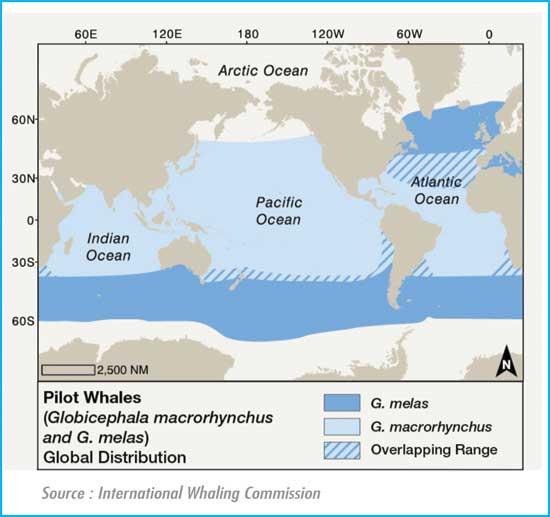Reply To:
Name - Reply Comment
Whale stranding along Panadura Coast

SL Navy officer engaged in the rescue operation.
Pic credits - SL Navy
- Wildlife Conservation Department says no abnormalities observed in post mortem report
- High tech cargo vessels and use of high-grade fuels should be encouraged
- High-frequency sonar used to detect oil deposits
On November 2, a little after daybreak, photos of a pod of short-finned pilot whales stranded along the Panadura coastal stretch started flooding social media newsfeeds. 
What followed was an approximately 18-hour operation to tackle the charismatic marine mammals, safely back into the waters. In no time, residents, volunteer groups, Sri Lanka Navy, emergency response teams and many other individuals joined hands in the rescue operation.
While around 120 of them safely returned home, six pilot whales and one dolphin succumbed to injuries.
However, the incident once again puts the spotlight on the need for robust marine insurance while raising concerns about the level of protection marine species have, given the geopolitical influences from surrounding nations.
No abnormalities observed
According to Dr Tharaka Prasad, Director – Wildlife Health at the Wildlife Conservation Department no abnormalities were observed in the post mortem report.
“External wounds have caused bleeding and there was less water space given the body pressure. The animals have grown to a height of 2.5 to three feet and when they turn to the left or right lateral position their blowholes are underwater.
“This is similar to someone holding us underwater with our nose held tight.
“Initially it was the general public who got involved in the rescue operation and they released the whales to the water thinking that it’s similar to a fish. They were of the impression that the whale should be underwater thereby adding pressure to the blowhole. There were instances when the whales deliberately tried to get some air but a few of them didn’t succeed.”
Ocean noise pollution 
According to his observations, Dr Terney Pradeep Kumara, marine biologist and General Manager at the Marine Environment Protection Authority, the reasons for this whale stranding could be manifold.
“Whales use sound for echolocation and have a special organ called ‘Melon’ in their forehead which they use for echolocation. Therefore, one of the reasons could be that they were moving away from high-frequency sonar emitted from vessels which are an irritation to marine animals.
“People use high-frequency sonar to detect oil and gas deposits and it causes a huge pressure on these animals.”
He said that so far there were no regulations in place to control oceanic noise pollution.
“We are in the process of amending the MEPA Act and one of the aspects is to include ocean noise pollution. But it will take time. There needs to be a discussion at the national level as well.”
Link to Malabar naval drills?
Several conservationists also speculated whether the annual ‘Malabar War Games’ had a possible link to the mass stranding of whales. According to The Economic Times, the Malabar Naval Drills being held by the Quadrilateral Security Dialogue (QSD, also known as the Quad) with India, US, Japan and the new entrant Australia, kicked off at the Bay of Bengal on Tuesday with frontline warships and submarines participating in complex exercises that include surface and anti-submarine warfare.
However, Sri Lanka Navy Spokesperson Captain Indika De Silva refuted claims.
“There’s no such evidence to link war games with the whale stranding incident. There is also no evidence to prove such militarization in our waters. Our territorial waters are within 12 nautical miles and any vessel can do an ‘innocent passage’. If they do something detrimental to national security or cause marine pollution then it’s not an innocent passage. If warships are entering our waters we are given prior notice. But outside territorial waters, they can do anything. None of the navies in the world has total control to regulate their waters,” he added.
Conservation status of pilot whales 
According to the International Whaling Commission, pilot whales were so named because it was believed that each observed group was navigated by a pilot or leader. There are two types of pilot whales: Short-finned pilot whales (Globicephala macrorhynchus) and long-finned pilot whales (G. melas). Short-finned pilot whales have a mostly tropical and warm temperate distribution both nearshore and open-ocean waters whereas long-finned pilot whales inhabit colder waters.
Pilot whales are generally nomadic but a few resident populations have been identified and studied in different locations. Short-finned pilot whales are native and are known to be found in many countries including Sri Lanka. Like killer and sperm whales, pilot whales form a stable family and social groups of 20-100 individuals. Pilot whales are the species most often involved in mass strandings throughout their range giving rise to various theories about its causes.
These theories include accidents in navigation that lead these animals to unexpectedly shallow waters, anomalies in the Earth’s geomagnetic fields caused by solar storms and impaired navigation in diseased individuals that lead the rest of the group astray. However, the latter theory was discredited to a certain extent by genetic analysis of pilot whales which showed that whales that are stranded together are not often closely related.
Short-finned pilot whales are known to be the subject of bycatch in many fisheries around the world. As top predators pilot whales also suffer from the bioaccumulation of contaminants such as heavy metals and organochlorine contaminants in their tissues which may have long term impacts on their breathing reproduction.
However, although long-finned and short-finned pilot whales are abundant in many parts of the world, there is some uncertainty about their taxonomy. Likely, populations grouped under one species now may represent multiple species or sub-species. As such, both species are designated as Data Deficient in the IUCN Red List of Threatened Species.

Marine experts claim that the reason for the whale stranding could be manifold, one of that being ocean noise pollution.
Pic credit - Lahiru Harshana
When the Panamanian oil tanker was burning in Sri Lankan waters, ecologists pointed out the robust need for  marine insurance. Dr Ranil Senanayake, Systems Ecologist and chairman of Rainforest Rescue International and Earth Restoration were one of them. Sharing his thoughts about the whale stranding incident, Dr Senanayake said that experienced personnel were not utilised in the rescue operation on time.
marine insurance. Dr Ranil Senanayake, Systems Ecologist and chairman of Rainforest Rescue International and Earth Restoration were one of them. Sharing his thoughts about the whale stranding incident, Dr Senanayake said that experienced personnel were not utilised in the rescue operation on time.
He also said that the most important control on speed and noise restrictions is to require that the shipping passing through our territorial waters take out insurance against spillage and damage to biodiversity. Excerpts :
Q What are your observations about the whale stranding incident?
This phenomenon has been observed with Pilot Whales before. The pod follows the lead whale if it makes a mistake through disease or injury and moves close to shore where the rest of the pod follows. The tragedy is that experienced personnel were not utilized in a timely manner.
Q How has the pandemic impacted marine animals?
As shipping continued unabated during the pandemic, there has not been any discernible reduction in the impact of Oceanic transport.
Q What are the impacts of ocean noise pollution on marine animals?
It is not only noise but direct physical impacts of oceanic pollution that affects many marine animals. An example is the case of the Blue Whales of Sri Lanka. These unique creatures live along the edge of the continental shelf, the same area that the great southern shipping lane passes through. I have witnessed the whales coming up to breathe in the shipping lane and sucking in a lungful of burnt bunker fuel-laden with poisons and heavy metals every time they come up.
Besides the massive machinery produces sound waves amplified by the ships hull. In short, one could say that the southern shipping lane is also one of the noisiest due to the volume of traffic that passes through it.
Q How are these sounds emitted? Are they mainly from naval vessels or all vessels in the deep seas?
The sounds are not only generated by the ships, they also could be generated by shore installations like the coal pier for the Norochcholai power plant. Metal impact and spillage create intense sound impact too.
Q Is there a mechanism to impose speed or noise restrictions on vessels?
The most important control that we can have is to require that the ships passing through our territorial waters take out insurance against spillage and damage to biodiversity.
Q What are the ways in which noise pollution in the ocean could be minimised?
Some possible ways are: the current trend of developing high tech sailing cargo vessels is encouraged or the use of bunker fuel to power shipping is changed to high-grade fuels.
